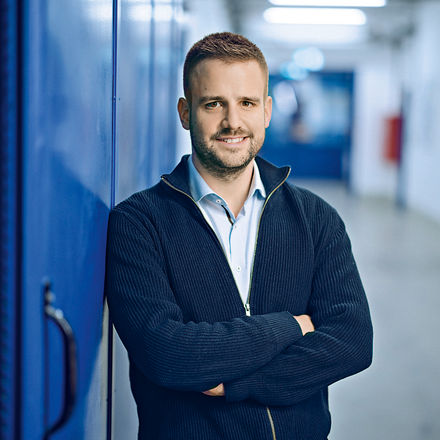When Dr. Christos Sarigiannidis travels from the Creavis headquarters in Marl to the Evonik location in Hanau, some 300 kilometers away, he prefers to take the train. At Creavis—Evonik’s strategic innovation unit and business incubator—Sarigiannidis is working on the future of mobility. One of his most important topics at the moment is technologies and materials that make batteries for electric vehicles even better.
On this day, Sarigiannidis, who hails from Greece, is visiting Evonik’s Electrochemistry & Exploration unit at Process Technology in Hanau. He looks through a pane of glass into an apparatus that holds several Petri dishes containing a slightly cloudy liquid that are being irradiated with UV light.
“The main component of the liquid is a monomer we have developed, which we are now polymerizing,” explains Sarigiannidis. The finished polymer can be examined in other Petri dishes, the bases of which are covered by a transparent, slightly yellowish mass. What looks like a fairly solid jelly is a great hope for one of Sarigiannidis’ projects. “This could one day serve as the electrolyte in solid-state lithium-ion batteries,” he says.

Millions of lithium-ion batteries (LIBs) are used to store electricity in electric vehicles. In the LIBs commonly used today, the space between the electrodes is filled with a liquid electrolyte. Solid-state electrolytes could help the tried-and-tested rechargeable batteries to make a leap forward in development, and accelerate electromobility. For Sarigiannidis, the advantages of solid-state batteries (SSBs) are obvious: “Solid-state batteries store more energy and are even safer than conventional LIBs,” he says.
Scientists and developers around the world are currently pursuing many approaches to further optimizing the range, charging speed, safety, and costs of these batteries. They have great expectations for SSBs. Some in the battery scene call them the “Holy Grail” or a game changer. “It’s an exciting field of work,” says Sarigiannidis. “At Evonik, we have expertise in a wide range of areas such as electrochemistry and polymer chemistry that enables us to be successful here.” There’s also a great deal of expertise in particle technology and materials science that is relevant to batteries.

The market for automotive batteries is already huge. According to the International Energy Agency, demand in this segment reached a record 750 gigawatt hours (GWh), or 750 million kilowatt hours (kWh), in 2023.
Of this, 415 GWh was attributable to car production in China, while a further 185 GWh was used in Europe. The capacity of a car battery is currently between 30 and 100 kWh.
ELEMENTS-Newsletter
Receive exciting insights into Evonik's research and its social relevance—conveniently via email.
The limits of the liquid electrolyte
The expected growth rates are even more impressive. According to market researchers, the global electric vehicle fleet (including hybrid models) could grow from just under 45 million vehicles in 2023 to between 500 and 800 million vehicles in the next ten years. The battery capacity required increases accordingly by a factor of seven to twelve. This will hardly be possible without technological leaps.
The biggest shortcomings of the current battery generation are relatively long charging times and that the range is usually exhausted at 300 to 400 kilometers. “No more great leaps are to be expected with the existing LIB technology,” says Sarigiannidis.

The fact that current technology is coming up against limits is due to compatibility issues between the anode and cathode materials with current liquid electrolytes. The switch to a solid electrolyte would also make it possible to use new materials for the electrodes. Conventional anodes consist of graphite in which lithium is embedded. Anodes made of pure lithium could significantly increase the batteries’ capacity.
“The potential storage capacity is significantly higher—by 30 to 40 percent,” says battery researcher Maximilian Fichtner from Ulm (see the interview starting on page 20). A solid-state electrolyte also increases safety due to the elimination of the flammable organic liquid. In addition, a solid-state battery no longer requires a separator.
Established cell manufacturers have long been working on such batteries, and well-known car manufacturers are supporting startups that are working on SSBs. More than 1.5 billion US dollars have been invested in this field in recent years. Evonik also wants to benefit from the SSB market and supply monomer building blocks for polymer electrolytes to battery manufacturers in the future.

No heat no power
The biggest challenge with solid electrolytes is to find a material that allows lithium ions to migrate through the rigid mass. “Developers are currently pursuing two fundamental approaches,” explains Sarigiannidis. “The first approach uses inorganic substances based on oxides or sulfides, the second organic polymers.” Combinations are also possible.
Despite intensive research worldwide, however, no material has yet been suitable for mass production. Every candidate has disadvantages. Sulfide materials, for example, are excellent conductors of lithium ions, but are not very chemically stable, says Sarigiannidis. Moreover, inorganic materials generally have the disadvantage that they are not flexible. However, this property is required to ensure a consistently good contact surface between the electrolyte and the electrode material during the volume fluctuations typical of LIBs. By comparison, solid polymers are much more flexible, but their conductivity is usually inadequate.
However, there is already a promising polymer that is able to conduct lithium ions well: polyethylene oxide (PEO). This is a chain of ethylene units, each of which is linked to the next by an oxygen atom. According to Sarigiannidis, a commercial vehicle equipped with a solid-state battery based on such a PEO electrolyte is already on the market in Europe. “However, this electrolyte only conducts ions well at or above a temperature of 70 degrees Celsius,” admits the researcher. So it has to be brought up to its operating temperature. But heating and insulation increase the amount of material and thus counteract the weight savings that SSBs are supposed to achieve.

Nevertheless, PEO is still considered an important candidate for solid-state batteries. In Sarigiannidis’ Creavis project, this material is also the starting point for development. It’s therefore very convenient that Evonik has decades of experience with PEO chemistry at its Essen location. This is where Dr. Jan Blankenburg comes in. Sarigiannidis hired the then recently graduated chemist at the end of 2019. Blankenburg has been rapidly pushing ahead with the solid electrolyte project since 2021.
“One problem with pure PEO is the formation of crystalline zones,” explains Blankenburg. These zones arise when polymer chains align themselves parallel to each other. “Lithium ions are practically unable to pass through such zones,” Blankenburg adds. Only above a certain temperature does the crystalline arrangement change to an amorphous one, enabling the ions to migrate between the electrodes again. “So our aim was to create a polymer that is also amorphous at lower temperatures.”
PEO should continue to play a role here because its oxygen atoms support ionic conduction. “We soon came up with the idea of combining PEO with another polymer,” says Blankenburg. The researcher likes to speak of “we,” but his boss Sarigiannidis is quick to clarify that the decisive considerations were solely thanks to his colleague.
Blankenburg’s idea was to use a polymer with a PMMA main chain that contains PEO in the form of side chains. Side chains are shorter, which makes them more flexible. In addition to oxygen, this flexibility is another factor that promotes the conductivity for the lithium ions. Blankenberg found what he was looking for in-house. Evonik had already developed the combination of PEO and PMMA in Darmstadt.
As a first step, colleagues at the Karlsruhe Institute of Technology (KIT) helped to measure how well such molecular constructs transport lithium ions. It was only at a later stage of the project that Sarigiannidis and Blankenburg also began to use the Evonik laboratories in Hanau. In the meantime, Blankenburg, who like Sarigiannidis initially had his office in Marl, moved his workplace completely to Hanau. The polymer layers in the Petri dishes that Sarigiannidis is shown on this day are the result of his work there.

Liquid versus solid

Combating crystals
However, this work began with a disappointment. “PMMA polymers with PEO side chains also conducted poorly at low temperatures,” says Blankenburg. Contrary to expectations, they also formed crystalline zones. But Blankenburg soon had another idea: “Why not simply incorporate an additional polymer building block into the PEO side chains—and have these blocks randomly distributed?” This irregularity should make crystal formation more difficult, so that the overall polymer remains conductive even when cooled.
The additional polymer building block was quickly found. Since then, the project has operated under the name AmPEOMA—an abbreviation for amorphous polyethylene oxide methacrylate.
In order to maintain the ionic conductivity over the widest possible temperature range, changes such as optimizing the lengths of the side chains were necessary. After all, an electric car should work just as well in sub-zero temperatures as it does at the height of summer. Many syntheses and material tests were necessary. The partners from KIT and later the Evonik colleagues at Electrochemistry & Exploration in Hanau also helped with this.
The first tests recently started there. To do this, the employees punch out a small circle from the jelly layer in the Petri dishes and insert it, together with two electrodes, into an empty coin cell. This cell is then clamped in an apparatus in which different currents can be applied and the voltage is then recorded. “This gives us an indication of the capacity,” explains Dr. Frank Löffler, a materials scientist at the Hanau laboratory. Long-term tests determine the cycle stability and thus the service life of a possible battery containing the AmPEOMA electrolyte. The findings for the coin cells can be transferred to later LIB cells for cars, says Blankenburg.

In the meantime, Sarigiannidis and his team have sent first samples of the new monomer to LIB battery cell manufacturers. More precisely, they sent the monomer—the cloudy liquid. “The actual polymerization is carried out by the manufacturer,” he says. “And it’s done directly in the battery cell.” Jan Blankenburg sees this as a particular process advantage. “Because it’s liquid, the monomer fills the space between the electrodes perfectly,” he says. In contrast to inorganic electrolytes, an optimum contact layer to the electrodes is created during curing. Furthermore, no additional solvent is required in the process.

»The monomer fills the space between the electrodes perfectly«
Jan Blankenburg Project Manager for the Mobility of the Future at Creavis
The feedback from manufacturers has been positive so far. However, there is still more work to be done. “We are currently trying to increase the mechanical stability, for example,” says Blankenburg. This means that the polymer, once cured, should be able to cope even better with the volume changes that typically occur in LIBs during the charging and discharging process. Blankenburg soon had an idea for this too: “We are currently trying to increase the mechanical stability of the polymer,” he explains. This is achieved by incorporating linkage points in the side chains of the monomer. Bonds to other molecules can be formed at these sites during curing.
As fast as filling a gas tank
For the tests so far, the Evonik researchers have produced polymer layers with a thickness of 200 micrometers (one-fifth of a millimeter). Later, in a commercially viable battery cell, the solid electrolyte layer will perhaps only measure 20 micrometers, making it thinner than a human hair. The team around Christos Sarigiannidis also has to ensure that the material can be produced in these dimensions without losing the desired properties.
In addition, the team also intends to further increase the ionic conductivity in order to shorten the charging time. Researchers hope that one day fully charging a solid-state battery will not take much longer than filling a gas tank.
And the signs are also positive when it comes to greater range. This is because SSBs will store more energy per kilogram of battery weight, as they have a higher energy density due to the use of a pure lithium anode. For LIBs currently available on the market, this is a maximum of 250 watt hours per kilogram of battery (Wh/kg), according to Christos Sarigiannidis. Battery experts expect that an SSB could achieve up to 400 Wh/kg. Energy densities of up to 700 Wh/kg have even been measured in laboratory tests. The Creavis researcher estimates that SSBs will be fitted in new vehicles on a significant scale from the 2030s onwards.


»Solid-state batteries store more energy and are even safer than conventional LIBs«
Christos Sarigiannidis head of the Mobility of the Future unit at Creavis
Given the significant increase in range and greater safety, even Sarigiannidis, a die-hard train traveler, can imagine making electric cars his main means of transport in a few years’ time

